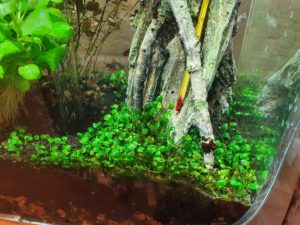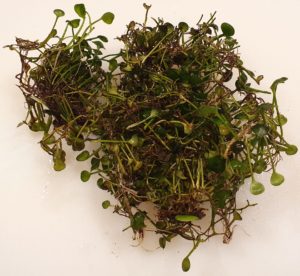
I like the look of the Marsilea and it’s the first carpeting plant I’ve had success with. I’m pretty sure most of what’s here is the hirsuta species which is reputedly both slightly larger and a little more robust than the crenata species. I mistakenly ordered the crenata first, planted that, then ordered the hirsuta and planted that as well so there may be a mix of species in here today, but they’re pretty similar in appearance (crenata is smaller).
Marsilea requires high light levels as can be seen by lack of growth in the shaded regions of the aquarium, particularly under the Lobelia. Otherwise the Marsilea does a nice job of filling in on its own. In my former “low tech” low light and no injected CO2 setup the Marsilea (of either species) didn’t really thrive and at best did a very very slow growth that might be better described as “didn’t die”.
I have only very infrequently spot trimmed the Marsilea where it’s come loose or a few stray leaves that grew extra tall in the over a year it’s been planted so that’s the ultimate in low maintenance. It looks nice and the shrimp seem to like it. I haven’t noticed that it traps a lot of debris – I do try to go at it with the water syphon during water changes but I’m not sure that’s really necessary.
Marsilea maintenance

Whilst the Marsilea leaves on stalks can be snipped off, this doesn’t hold the plant back for very long. Where the Marsilea has become excessively wooly, since the plant spreads linearly with runners it is straightforward to use pinsettes to pull up a whole “line” of Marsilea where a quick snip at either end releases a string of the plant. Once the Marsilea gets going it makes a quite dense carpet that is difficult to “plant through” if you want to put in new plants, so I think it’s best to not be too shy about vigorously pulling back excess material or plants that have strayed beyond where you’d like them to be.
I recently decided to clear the Marsilea from the left side of the Fireplace Aquarium to make room for some new Cryptocoryne parva. There was a substantial amount of Marsilea on the left, all of which resulted from natural spread from the right side of the tank.